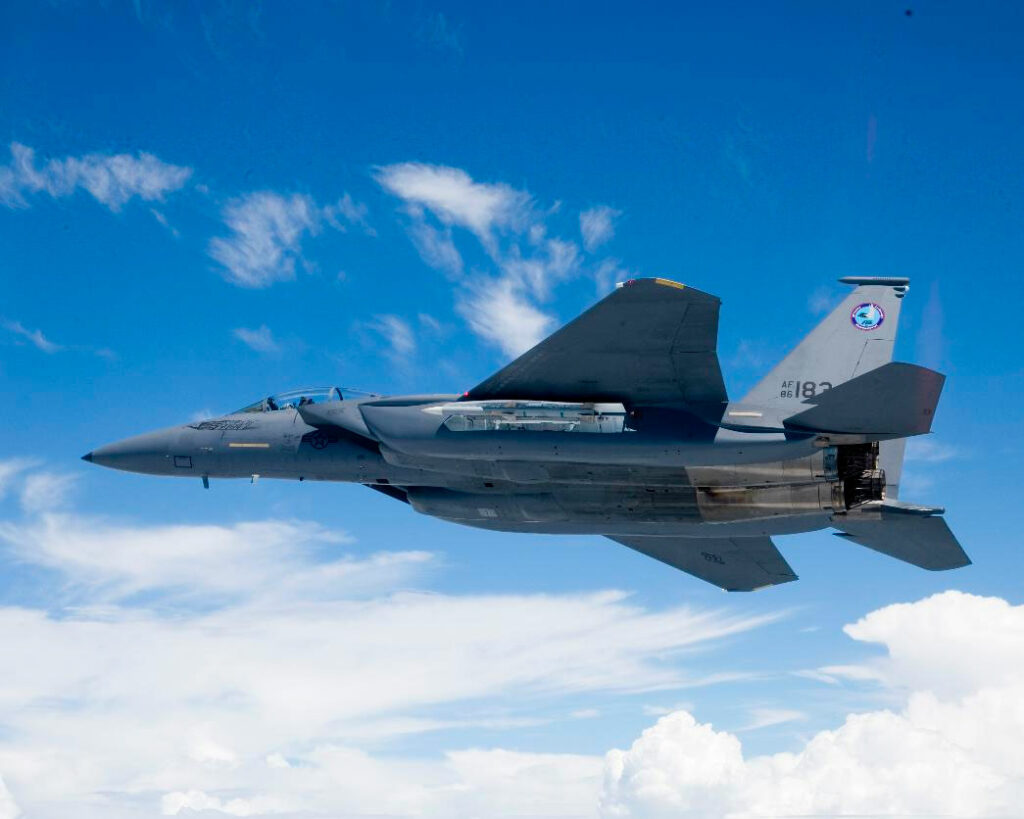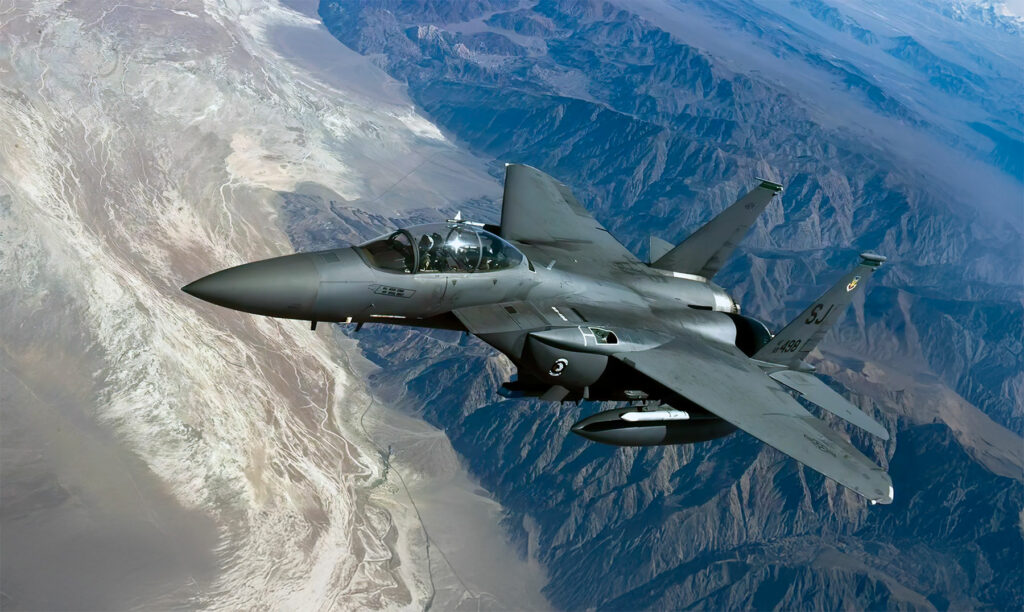Boeing F-15SE Silent Eagle – A stealth-capable fighter variant of the F-15, designed for reduced radar visibility and enhanced survivability.
In brief
The Boeing F-15SE Silent Eagle is a stealth-enhanced variant of the F-15 Strike Eagle, developed to meet modern air combat demands. Equipped with canted vertical tails, radar-absorbent material, and conformal weapon bays, the F-15SE offers reduced radar cross-section while retaining the speed, agility, and payload capacity of the original F-15. The Silent Eagle includes twin Pratt & Whitney F100-PW-229 engines, each providing up to 29,000 pounds (13,154 kg) of thrust, achieving speeds over Mach 2.5. With a combat range of approximately 1,100 miles (1,770 km) and a service ceiling of 65,000 feet (19,812 meters), it is suited for air superiority and ground-attack missions. Boeing designed the Silent Eagle with advanced avionics and targeting systems, making it a capable multi-role aircraft that blends traditional F-15 strengths with upgraded stealth characteristics for improved survivability.

The Boeing F-15SE Silent Eagle
The Boeing F-15SE Silent Eagle represents a significant upgrade to the classic F-15 design, with stealth features aimed at reducing its radar visibility. Originally conceived as a potential solution for nations looking to acquire stealth capabilities without fully investing in fifth-generation fighters, the F-15SE incorporates advanced design elements while retaining the performance and versatility of the F-15. Though it ultimately did not receive widespread adoption, the Silent Eagle remains a notable entry in the evolution of the F-15 series.
History of Development
The F-15SE Silent Eagle emerged during a period when air forces around the world were increasingly interested in stealth technology. By the early 2000s, fifth-generation fighters like the F-22 Raptor and F-35 Lightning II showcased the advantages of low observable technology. However, many countries lacked access to these advanced platforms due to costs and export restrictions. Boeing saw an opportunity to offer a more affordable solution by modifying the F-15 into a stealthier version, resulting in the F-15SE program.
Launched in 2009, the F-15SE aimed to retain the power and reliability of the Strike Eagle while incorporating stealth features. Boeing designed the Silent Eagle as a competitor for nations needing an advanced aircraft capable of performing in both air superiority and strike roles. It featured conformal fuel tanks, redesigned as conformal weapon bays (CWBs), allowing it to carry weapons internally, reducing its radar cross-section. This feature, along with canted vertical stabilizers and radar-absorbent coatings, contributed to the aircraft’s stealth capabilities.
The F-15SE’s first flight was conducted on July 8, 2010, demonstrating its capabilities to potential international customers. While Boeing marketed the Silent Eagle primarily to countries like South Korea and Saudi Arabia, neither ultimately chose to pursue the F-15SE, opting instead for other platforms. Despite this, the Silent Eagle’s development marked an important step in Boeing’s efforts to keep the F-15 relevant in an era dominated by stealth technology.
Design
The design of the F-15SE Silent Eagle centers on stealth enhancements, using a modified F-15E Strike Eagle frame. The Silent Eagle features canted vertical stabilizers angled at 15 degrees outward, which helps reduce the aircraft’s radar cross-section. This change affects the aircraft’s aerodynamics, but careful engineering allows the F-15SE to maintain stability and agility comparable to its predecessors.
The aircraft is equipped with Conformal Weapon Bays (CWBs), which replace traditional conformal fuel tanks. These CWBs are capable of housing air-to-air missiles like the AIM-120 AMRAAM or air-to-ground ordnance such as Joint Direct Attack Munitions (JDAMs). Each bay can hold up to two weapons, reducing the need for external pylons, which would increase radar visibility. While this configuration slightly reduces the overall weapons load, it significantly enhances the aircraft’s stealth profile.
The F-15SE uses radar-absorbent material (RAM) coatings on various surfaces to reduce its radar signature further. These coatings, combined with internal weapons storage, make the Silent Eagle less detectable by enemy radar. However, these stealth features primarily benefit frontal radar cross-section reduction, with limited effectiveness against side and rear-facing radar systems.
Performance
The F-15SE Silent Eagle is powered by two Pratt & Whitney F100-PW-229 engines, each providing 29,000 pounds (13,154 kg) of thrust. This allows the aircraft to reach speeds exceeding Mach 2.5, or roughly 1,875 mph (3,017 km/h) at altitude. Despite its modifications for stealth, the F-15SE maintains much of the original F-15’s speed and agility, with a maximum takeoff weight of 81,000 pounds (36,741 kg) and a thrust-to-weight ratio that supports rapid acceleration and high maneuverability.
The aircraft’s combat range is approximately 1,100 miles (1,770 km) without external fuel tanks, while the service ceiling is 65,000 feet (19,812 meters). In terms of range and altitude, the F-15SE is comparable to fifth-generation fighters like the F-35, though it does not match their stealth capabilities. The Silent Eagle can carry up to 23,000 pounds (10,433 kg) of ordnance across its wings, fuselage, and CWBs, though internal storage within the CWBs limits this payload slightly compared to the standard F-15E configuration.
When compared to other aircraft such as the F-35 or even newer iterations of the Su-57, the F-15SE’s stealth features are less advanced, as it primarily focuses on frontal radar reduction. However, its speed and payload capacity surpass the F-35, offering a different balance of capabilities that may appeal to countries with specific operational needs.
Variants
The F-15SE Silent Eagle does not have multiple distinct variants like some other aircraft. Boeing initially developed the baseline model with plans to tailor modifications based on customer requirements. The primary variant of the Silent Eagle is the F-15SE itself, incorporating conformal weapon bays, canted vertical stabilizers, and radar-absorbent coatings.
Though Boeing envisioned several possible configurations, including variants with external weapon pylons for increased payload at the cost of stealth, these were not fully developed due to limited customer interest. The Silent Eagle program primarily targeted international markets with customized avionics and electronic warfare suites to meet the specific requirements of potential buyers. Despite limited sales, Boeing used lessons from the F-15SE in other F-15 projects, refining stealth and electronic warfare capabilities that influenced later models.

Military Use and Combat
The F-15SE Silent Eagle was designed to provide stealth capabilities to countries unable to access fifth-generation fighters but was not widely adopted. Due to its development as a stealth-enhanced variant, its primary role would have been air superiority and precision strike missions where radar evasion was crucial. The Silent Eagle’s armament is versatile, allowing it to carry AIM-120 AMRAAMs, AIM-9X Sidewinders, JDAMs, and a variety of other ordnance, suitable for both air-to-air and air-to-ground roles.
Although it was proposed for countries such as South Korea and Saudi Arabia, neither ultimately purchased the aircraft. In South Korea’s case, the F-35 was selected over the Silent Eagle. Saudi Arabia expanded its existing fleet of F-15SAs, which did not include the full stealth capabilities of the F-15SE. The Silent Eagle was also pitched to other nations but failed to secure contracts.
The aircraft did not see combat, as it was not operationally deployed by any air force. However, it would have been well-suited for missions where the need for low radar visibility and high-speed engagement was essential. Its design was primarily aimed at countering advanced air defense systems and maintaining air superiority in contested environments, leveraging the F-15’s proven combat capabilities with enhanced survivability.
Boeing continues to support other F-15 models in active service, with ongoing upgrades and modifications to improve their capabilities. The F-15EX, for example, incorporates lessons from the F-15SE project, though it focuses less on stealth and more on updated avionics, weapons systems, and enhanced payload capacity. The Silent Eagle, while not in service, contributed to the overall evolution of the F-15 platform, informing future designs and upgrades within Boeing’s fighter aircraft portfolio.
Back to the Fighter Jet section.